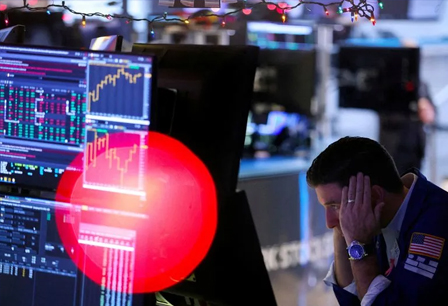U.S. stocks fell sharply on Friday to suffer their biggest one-day drop since 2020, as investors continued to weigh hawkish comments on interest rates a day earlier by Federal Reserve Chairman Jerome Powell, as well as a fresh batch of corporate earnings that largely disappointed.
How did stocks trade?
The Dow Jones Industrial Average DJIA, -2.82% fell 981.36 points, or 2.8%, to close at 33,811.40, after declining 1,019 points at its session low. The blue-chip gauge saw its steepest one-day percentage loss since Oct. 28, 2020.
The S&P 500 SPX, -2.77% dropped 121.88 points, or 2.8%, to end at 4,271.78.
The Nasdaq Composite COMP, -2.55% finished at 12,839.29 after a drop of 335.35 points, or 2.6%. The S&P 500 and Nasdaq each suffered their biggest one-day drops since March 7.
The Dow and S&P 500 on Friday posted their lowest finishes since March 15, while the Nasdaq closed at its lowest since March 14.
On Thursday, stocks gave up strong gains, reversing sharply lower. With Friday’s plunge, the Dow suffered a 1.9% weekly decline, its fourth straight loss. The S&P 500 dropped 2.8% and the Nasdaq tumbled 3.8% for their third consecutive weekly drops.
What drove the market?
Stock-market weakness picked up Friday where Thursday’s selloff left off, when equities tumbled into the afternoon after Powell added his support for moving faster on raising interest rates to cool inflation, measures that would include a possible 50 basis point interest rate hike in May.
“It would seem investors have been too complacent about the upcoming [Fed] meeting, which will need to change,” said Michael Kramer, founder of Mott Capital, in a note.
The Cboe Volatility Index VIX, +24.38%, an options-based measure of expected volatility over the next 30 days, had been too low heading into the May 3-4 Federal Open Market Committee, or FOMC, meeting, Kramer said. It rose Thursday and was up another 19.5% at 27.1- on Friday, moving above its long-term average just below 20.
Powell’s remarks appeared to make a half percentage point rate hike the base case, with the central bank also likely to announce the beginning of the unwinding of its balance sheet, Kramer said.
Meanwhile, traders of fed funds futures have priced in a 94% chance that the Federal Reserve will deliver a 75 basis point rate hike in June, up from 70% on Thursday and 28% a week ago, according to the CME FedWatch Tool.
Stocks trimmed losses somewhat in afternoon activity after Cleveland Fed President Loretta Mester, in a television interview, said she remained in favor of 50 basis point rate increases, but saw no need for the “shock” of a 75 basis point increase. The bounce proved short-lived, however, with stocks falling to new session lows ahead of the closing bell.
The benchmark 10-year Treasury yield TMUBMUSD10Y, 2.903%, meanwhile, pulled back slightly to around 2.89% after climbing about 8.1 basis points to 2.917% on Thursday, the highest since Dec. 4, 2018.
The Fed’s hawkish shift and the relentless rise in Treasury yields may be sapping the previous appeal of equities, which had previously been seen as the only viable avenue for many return-seeking investors.
“Investors appear to be moving away from the TINA (There is no Alternative) narrative as of late when it comes to equities,” said Brian Price, head of investment management at Commonwealth Financial Network, in a note. “This is the second straight week of significant outflows from equity mutual funds and days like today are unlikely to change the sentiment moving forward. The one positive takeaway may be that sentiment has become too bearish and we could see a countertrend rally at some point in the coming weeks.”
In One Chart: Investors just pulled a massive $17.5 billion out of global equities. They’re just getting started, says Bank of America.
All 11 major S&P 500 sectors fell Friday, with healthcare dropping 3.6% after a downbeat profit forecast from HCA Healthcare Inc. HCA, -21.82% sent its shares tumbling 21.8%. Other hospital operators, including Tenet Healthcare Corp. THC, -15.65%, Community Health Systems Inc. CYH, -17.93% and Universal Health Services UHS, -13.96% also fell between 14% to 17.9%.
However, of the 99 companies in the S&P 500 that have reported earnings for the first quarter, 77.8% of them have beat market expectations. Typically, 66% of companies beat estimates, according to Refinitiv data.
Next week will mark another big week for earnings, with 558 companies reporting, Saxo noted. “It is the big test of companies’ ability to pass on costs to their customers,” they said.
Investors may also be skittish ahead of the final round of France’s presidential election on Sunday. An upset victory by far-right candidate Marine Le Pen over incumbent Francois Macron would likely spark market volatility, analysts said.












